Doxorubicin effect is enhanced by sphingosine-1-phosphate signaling antagonist in breast cancer
- PMID: 29078883
- PMCID: PMC5661979
- DOI: 10.1016/j.jss.2017.05.101
Doxorubicin effect is enhanced by sphingosine-1-phosphate signaling antagonist in breast cancer
Abstract
Background: Doxorubicin is one of the most commonly used chemotherapeutic drugs for breast cancer; however, its use is limited by drug resistance and side effects. We hypothesized that adding FTY720, a sphingosine-1-phosphate (S1P) receptor functional antagonist, to doxorubicin would potentiate its effects by suppression of drug-induced inflammation.
Materials and methods: The Cancer Genome Atlas, Gene Expression Omnibus data sets, and National Cancer Institute-60 panel were used for gene expressions and gene set enrichment analysis. E0771 syngeneic mammary tumor cells were used. OB/OB mice fed with western high-fat diet were used as an obesity model.
Results: STAT3 expression was significantly increased after doxorubicin treatment in human breast cancer that implicates that doxorubicin evokes inflammation. Expression of sphingosine kinase 1, the enzyme that produces S1P and links inflammation and cancer, tended to be higher in doxorubicin-resistant human cancer and cell lines. In a murine breast cancer model, sphingosine kinase 1, S1P receptor 1, interleukin 6, and STAT3 were overexpressed in the doxorubicin-treated group, whereas all of them were significantly suppressed with addition of FTY720. Combination therapy synergistically suppressed cancer growth both in vitro and in vivo. Furthermore, combination therapy showed higher efficacy in an obesity breast cancer model, where high body mass index demonstrated trends toward worse disease-free and overall survival, and high-serum S1P levels in human patients and volunteers.
Conclusions: We found that FTY720 enhanced the efficacy of doxorubicin by suppression of drug-induced inflammation, and combination therapy showed stronger effect in obesity-related breast cancer.
Keywords: Breast cancer; Doxorubicin; FTY720; Mouse model; Obesity; Sphingosine-1-phosphate.
Copyright © 2017 Elsevier Inc. All rights reserved.
Figures





References
-
- Carvalho C, Santos RX, Cardoso S, Correia S, Oliveira PJ, et al. Doxorubicin: the good, the bad and the ugly effect. Current medicinal chemistry. 2009;16:3267–3285. - PubMed
-
- De Laurentiis M, Cancello G, D’Agostino D, Giuliano M, Giordano A, et al. Taxane-based combinations as adjuvant chemotherapy of early breast cancer: a meta-analysis of randomized trials. Journal of clinical oncology: official journal of the American Society of Clinical Oncology. 2008;26:44–53. - PubMed
-
- Gonzalez-Angulo AM, Morales-Vasquez F, Hortobagyi GN. Overview of resistance to systemic therapy in patients with breast cancer. Advances in experimental medicine and biology. 2007;608:1–22. - PubMed
-
- Singhal SS, Singhal J, Sharma R, Singh SV, Zimniak P, et al. Role of RLIP76 in lung cancer doxorubicin resistance: I. The ATPase activity of RLIP76 correlates with doxorubicin and 4-hydroxynonenal resistance in lung cancer cells. International journal of oncology. 2003;22:365–375. - PubMed
Publication types
MeSH terms
Substances
Grants and funding
LinkOut - more resources
Full Text Sources
Other Literature Sources
Medical
Miscellaneous

